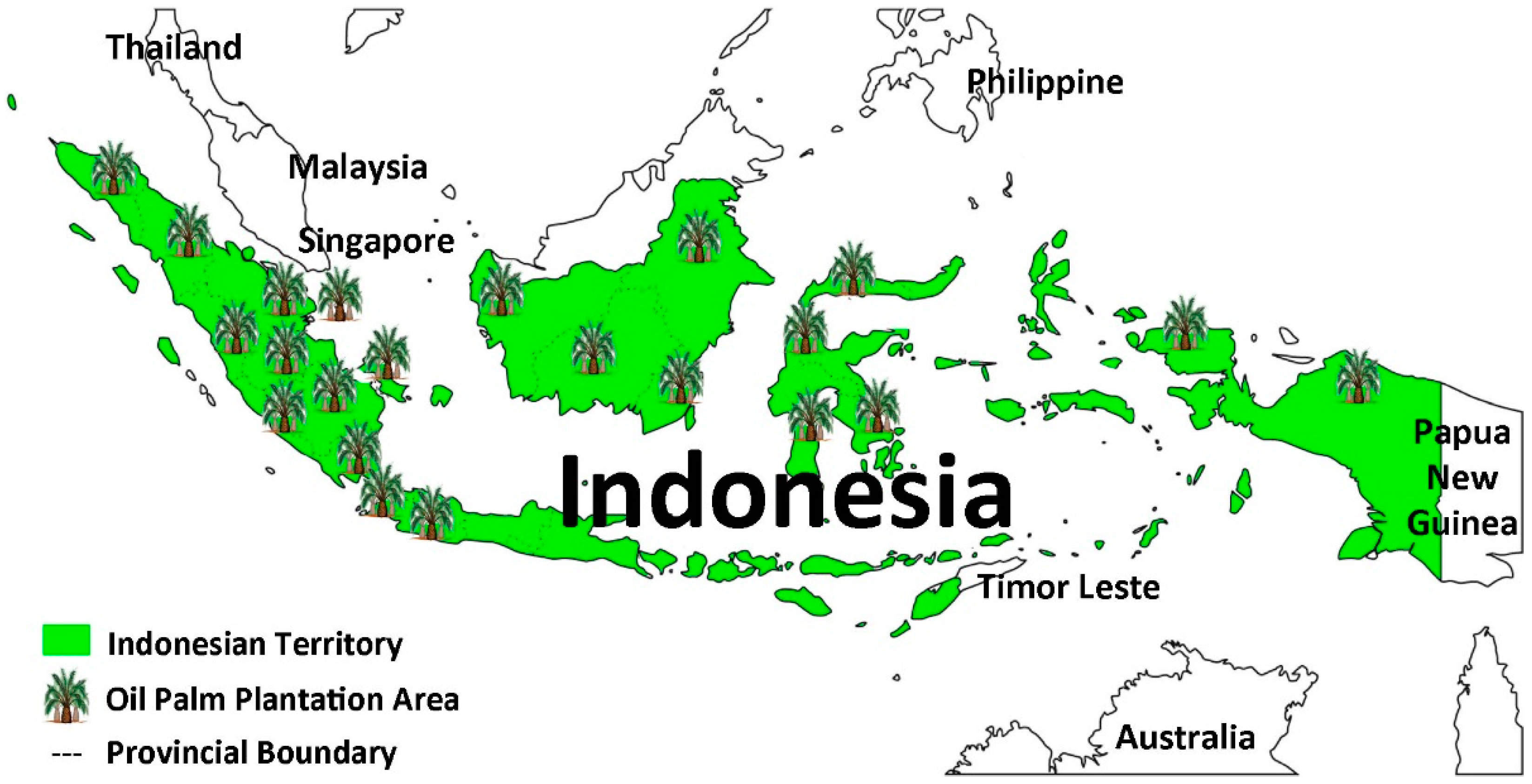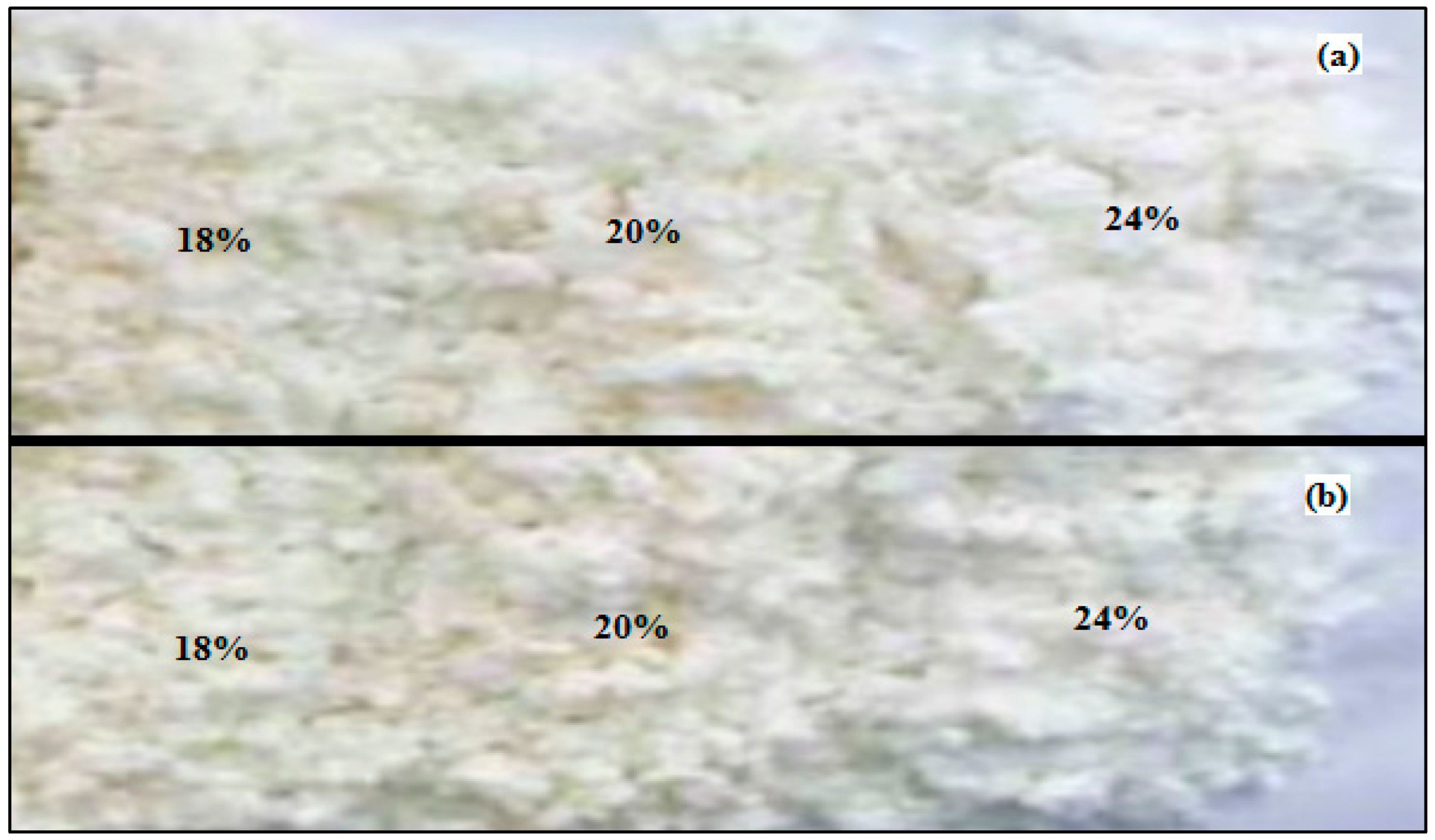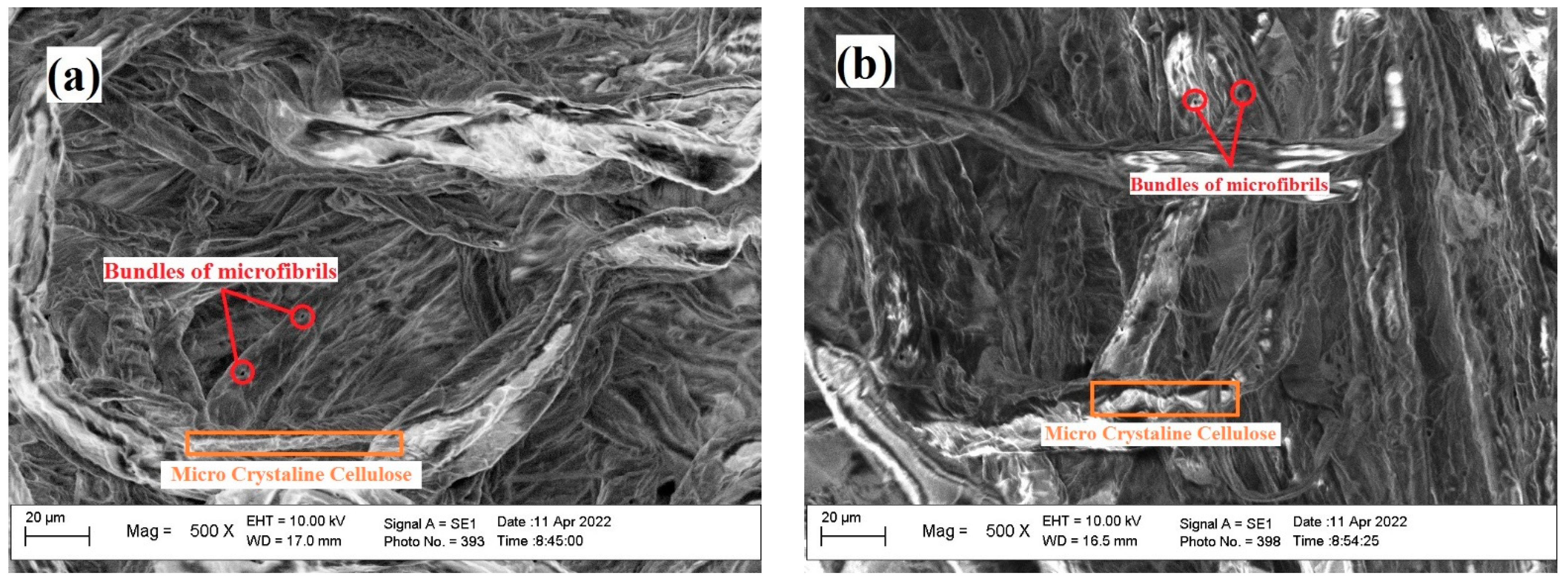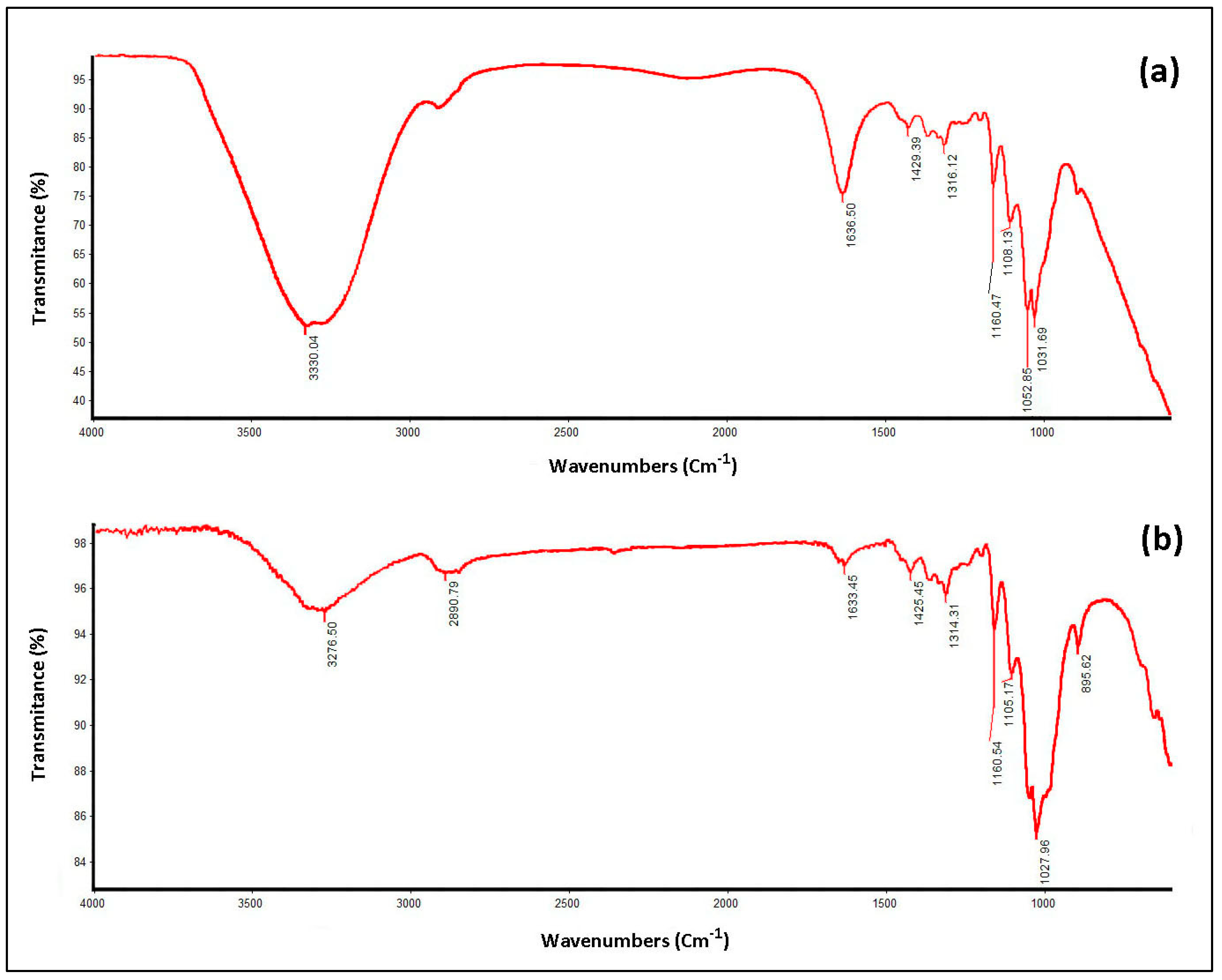Oil Palm Empty Fruit Bunches as Raw Material of Dissolving Pulp for Viscose Rayon Fiber in Making Textile Products
Abstract
:1. Introduction
2. Materials and Methods
2.1. Preparation Stage
2.2. Pre-Hydrolysis Stage
2.3. Cooking Process
2.4. Bleaching
2.5. Dissolving Pulp (DP)
3. Results
3.1. Analysis Results of Empty Fruit Bunches (EFB)
3.2. Dissolving Pulp (DP) and Rayon Viscose Fiber (RVF)
3.3. Chemical Characteristics of EFB Using Fourier Transform Infrared Spectroscopy (FTIR)
3.4. Chemical Characteristics of EFB Using X-ray Diffraction (XRD)
4. Conclusions
Author Contributions
Funding
Institutional Review Board Statement
Informed Consent Statement
Data Availability Statement
Acknowledgments
Conflicts of Interest
References
- Subagja, I.K. Creative industry competitiveness in Indonesia. Int. J. Acad. Res. Dev. 2017, 2, 428–439. [Google Scholar]
- Ahman, E.; Machmud, A.; Sumawidjadja, R.N.; Herlinawati, E. Model of The Competitive Advantage of Creative Industries in Indonesia based on Helix Quadruple, Creativity and Innovation Capability. Int. J. Innov. Creat. Chang. 2020, 11, 516–532. [Google Scholar]
- Husin, R.; Hidayah, N.; Mukmin, T.M. Creative Industries in Supporting Indonesia’s Economic Growth in Innovation Perspective. Bus. Econ. J. 2021, 12, 1–4. [Google Scholar]
- Pooja, S.; Othman, S.; Rokia, H.; Leh, C.P.; Rajeev, P.S. Using biomass residues from oil palm industry as a raw material for pulp and paper industry: Potential benefits and threat to the environment. Environ. Dev. Sustain. 2013, 15, 367–383. [Google Scholar]
- Sequiño, A.C.; Avenido, J.M. The World’s Leader in the Palm Oil Industry: Indonesia. Int. J. Ecol. Conserv. 2015, 13, 152–164. [Google Scholar] [CrossRef]
- Sulaiman, F.; Abdullah, N.; Gerhauser, H.; Shariff, A. An outlook of Malaysian energy, oil palm industry and its utilization of wastes as useful resources. Biomass Bioenerg. 2011, 35, 3775–3786. [Google Scholar] [CrossRef]
- Yunos, N.S.H.M.; Baharuddin, A.S.; Yunos, K.F.M.; Hafid, H.S.; Busu, Z.; Mokhtar, M.N.; Sulaiman, A.; Som, A.M. The physicochemical characteristics of residual oil and fibers from oil palm empty fruit bunches. Bioresources 2015, 10, 14–29. [Google Scholar] [CrossRef] [Green Version]
- Andrade, M.F.; Colodette, J.L. Dissolving pulp production from sugar cane bagasse. Ind. Crop. Prod. 2014, 52, 58–64. [Google Scholar] [CrossRef]
- T204 cm-07; Solvent Extractives of Wood and Pulp. TAPPI: Atlanta, GA, USA, 2007. Available online: www.tappi.org/Bookstore/Standards-TIPs/Standards/ (accessed on 21 December 2021).
- Yoshihara, K.; Kobayashi, T.; Fujii, T.; Akamatsu, I. A novel modification of Klason lignin quantitative method. Jpn. Tappi J. 1984, 38, 466–475. [Google Scholar] [CrossRef]
- Ohi, H.; Ju, Y.; Kuroda, K. Structural analysis of lignin by pyrolysis-gas chromatography (VII) Conditions for acid hydrolysis of wood pulps and characteristics of acid-insoluble residues. Jpn. Tappi J. 1997, 51, 1578–1586. [Google Scholar] [CrossRef]
- T222 om-11; Acid-Insoluble Lignin in Wood and Pulp. TAPPI: Atlanta, GA, USA, 2011. Available online: www.tappi.org/Bookstore/Standards-TIPs/Standards/ (accessed on 21 December 2021).
- Harsono, H.; Putra, A.S.; Maryana, R.; Rizaluddin, A.T.; H’ng, Y.Y.; Izumi, A.N.; Ohi, H. Preparation of dissolving pulp from oil palm empty fruit bunch by prehydrolysis soda-anthraquinone cooking method. J. Wood Sci. 2016, 62, 65–73. [Google Scholar] [CrossRef] [Green Version]
- Tanifuji, K.; Takahashi, S.; Kajiyama, M.; Ohi, H. Advantage of acid sulfite cooking as process of bioethanol production. Jpn. Tappi J. 2011, 65, 494–505. [Google Scholar] [CrossRef] [Green Version]
- T211 om-12; Ash in Wood, Pulp, Paper and Paperboard. TAPPI: Atlanta, GA, USA, 2012. Available online: www.tappi.org/Bookstore/Standards-TIPs/Standards/ (accessed on 21 December 2021).
- Hasumi, A.; Nakagawa, I.A.; Homma, M.; Ohi, H.; Nakamata, K. Structural micro-analysis of residual lignin in pulp by pyrolysis-GC mass-spectrometry. Jpn. Tappi J. 2009, 63, 959–970. [Google Scholar] [CrossRef] [Green Version]
- T236 om-13; Kappa Number of Pulp. TAPPI: Atlanta, GA, USA, 2013. Available online: www.tappi.org/Bookstore/Standards-TIPs/Standards/ (accessed on 21 December 2021).
- T230 om-13; Viscosity of Pulp (Capillary Viscometer Method). TAPPI: Atlanta, GA, USA, 2013. Available online: www.tappi.org/Bookstore/Standards-TIPs/Standards/ (accessed on 21 December 2021).
- T452 om-08; Brightness of Pulp, Paper and Paperboard (Directional Reflectance at 457 nm). TAPPI: Atlanta, GA, USA, 2008. Available online: www.tappi.org/Bookstore/Standards-TIPs/Standards/ (accessed on 21 December 2021).
- T203 cm-09; Alpha-, Beta- and Gamma-Cellulose in Pulp. TAPPI: Atlanta, GA, USA, 2009. Available online: www.tappi.org/Bookstore/Standards-TIPs/Standards/ (accessed on 21 December 2021).
- Ale’n, R. Basic chemistry of wood delignification. In Forest Product Chemistry (Papermaking Science and Technology, Book 3); Stenius, P., Ed.; PI and TAPPI Press: Helsinki, Finland, 2000. [Google Scholar]
- Ma, X.; Huang, L.; Chen, Y.; Cao, S.; Chen, L. Preparation of bamboo dissolving pulp for textile production. Part 1. Study on prehydrolysis of green bamboo for producing dissolving pulp. Bioresources 2011, 6, 1428–1439. [Google Scholar]
- Ma, X.; Huang, L.; Cao, S.; Chen, Y.; Luo, X.; Chen, L. Preparation of dissolving pulp from bamboo for textile applications. Part 2. Optimization of pulping conditions of hydrolyzed bamboo and its kinetics. Bioresources 2012, 7, 1866–1875. [Google Scholar] [CrossRef] [Green Version]
- Konsomboon, S.; Pipatmanomai, S.; Madhiyanon, T.; Tia, S. Effect of kaolin addition on ash characteristics of palm empty fruit bunch (EFB) upon combustion. Appl. Energy 2011, 88, 298–305. [Google Scholar] [CrossRef]
- Sharma, A.K.; Anupam, K.; Swaroop, V.; Lal, P.S.; Bist, V. Pilot scale soda-anthraquinone pulping of palm oil empty fruit bunches and elemental chlorine free bleaching of resulting pulp. J. Clean Prod. 2015, 106, 422–429. [Google Scholar] [CrossRef]
- Standard Nasional Indonesia (SNI) 0938:2017; Pulp Rayon. National standard Agency of Indonesia (BSN): Jakarta, Indonesia, 2017. Available online: www.sisni.bsn.go.id/index.php?/sni_main/sni/detail_sni/9701 (accessed on 21 December 2021). (In Indonesian)
- Abdurrahman, A.; Umam, R.; Irzaman, I.; Palupi, E.K.; Saregar, A.; Syazali, M.; Junaidi, R.; Wahyudianto, B.; Adi, L.C. Optimization and interpretation of heat distribution in sterilization room usingconvection pipe. Indones. J. Sci. Technol. 2019, 4, 204–219. [Google Scholar] [CrossRef]
- Hermawan, B.; Nikmatin, S.; Sudaryanto; Alatas, H.; Sukaryo, S.G. Effect of oil palm empty fruit bunches fibers reinforced polymer recycled. IOP Conf. Ser. Mater. Sci. Eng. 2017, 223, 012064. [Google Scholar] [CrossRef] [Green Version]
- Irzaman, I.; Cahyani, I.D.; Aminullah, A.; Maddu, A.; Yuliarto, B.; Siregar, U. Biosilica properties from rice husk using various HCL concentrations and frequency sources. Egypt. J. Chem. 2019, 63, 363–371. [Google Scholar] [CrossRef]
- Nikmatin, S.; Hermawan, B.; Irmansyah, I.; Indro, M.N.; Kueh, A.B.H.; Syafiuddin, A. Evaluation of the performance of helmet prototypes fabricated from acrylonitrile butadiene styrene composites filled with natural resource. Materials 2018, 12, 34. [Google Scholar] [CrossRef] [PubMed] [Green Version]
- Nikmatin, S.; Syafiuddin, A.; Kueh, A.B.H.; Purwanto, Y.A. Effects of nanoparticle filler on thermo-physical properties of rattan powder-filled polypropylene composites. J. Teknol. 2015, 77, 1–6. [Google Scholar] [CrossRef] [Green Version]
- Umam, R.; Sommanawat, K. Strategic flexibility, manufacturing flexibility, and firm performance under the presence of an agile supply chain: A case of strategic management in fashion industry. Pol. J. Manag. Stud. 2019, 19, 407–418. [Google Scholar] [CrossRef]
- Sabara, Z.; Afiah, I.N.; Umam, R. Integration of Green Ergonomics in Robust Decision Making Approach in Water Resources Management in Makassar City. Int. J. Technol. 2022, 13, 264–273. [Google Scholar] [CrossRef]
- Sabara, Z.; Anwar, A.; Yani, S.; Prianto, K.; Junaidi, R.; Umam, R.; Prastowo, R. Activated Carbon and Coconut Coir with the Incorporation of ABR System as Greywater Filter: The Implications for Wastewater Treatment. Sustainability 2022, 14, 1026. [Google Scholar] [CrossRef]
- Rufaidah, E.; As’atirsyadi, K.; Saregar, A.; Umam, R. The effect of halal label to increase domestic and international tourism: Case study in Lombok, Indonesia. Int. J. Manag. Bus. Res. 2018, 8, 29–36. [Google Scholar]
- Sriyakul, T.; Umam, R.; Jermsittiparsert, K. Total quality management and logistic performance: Moderating role of reserve supply chain in pharmaceutical industry of Indonesia. Int. J. Innov. Creat. Chang. 2019, 5, 228–248. [Google Scholar]
- Adnyano, A.A.I.A.; Prastowo, R.; Bahy, M.N.; Hikmahtiar, S.; Said, A.; Ashadi, A.L. Application of Mine Dewatering Methods to Reduce Wastewater Pollution in The Environment: Implications for Andesite Mining. Int. J. Hydrol. Environ. Sustain. 2022, 1, 24–32. [Google Scholar]
- Sabara, Z.; Mutmainnah, A.; Kalsum, U.; Afiah, I.N.; Husna, I.; Saregar, A.; Irzaman; Umam, R. Sugarcane Bagasse as the Source of Nanocrystalline Cellulose for Gelatin-Free Capsule Shell. Int. J. Biomater. 2022, 2022, 9889127. [Google Scholar] [CrossRef]
- Wan, R.W.D.; Leh, C.P.; Zainuddin, Z.; Tanaka, R. Effects of prehydrolysis on the production of dissolving pulp from empty fruit bunches. J. Trop. For. Sci. 2014, 16, 343–349. [Google Scholar]
- Wan, R.W.D.; Leh, C.P.; Zainuddin, Z.; Tanaka, R. Optimisation of soda pulping variables for preparation of dissolving pulps from oil palm fibre. Holzforschung 2003, 57, 106–113. [Google Scholar]
- Leh, C.P.; Wan, R.W.D.; Zainuddin, Z.; Tanaka, R. Optimisation of oxygen delignification in production of totally chlorine-free cellulose pulps from oil palm empty fruit bunch fibre. Ind. Crop. Prod. 2008, 28, 260–267. [Google Scholar] [CrossRef]
- Tanaka, R.; Wan, R.W.D.; Magara, K.; Ikeda, T.; Hosoya, S. Chlorine-free bleaching of kraft pulp from oil palm empty fruit bunches. Jpn. Agric. Res. Q. JARQ 2004, 39, 275–279. [Google Scholar] [CrossRef] [Green Version]
- Muhammad, D.F.; Asad, M.; Mohamad, I.M.N.; Wan, R.W.D. Synthesis and characterization of cellulose acetate from TCF oil palm empty fruit bunch pulp. Bioresources 2014, 9, 4710–4721. [Google Scholar] [CrossRef] [Green Version]
- Rizaluddin, A.T.; Liu, Q.; Panggabean, P.R.; Ohi, H.; Nakamata, K. Application of peroxymonosulfuric acid as a modification of the totally chlorine-free bleaching of acacia wood prehydrolysis-kraft pulp. J. Wood Sci. 2015, 61, 292–298. [Google Scholar] [CrossRef]
- Wahyuni, H.; Aladin, A.; Kalla, R.; Nouman, M.; Ardimas, A.; Chowdhury, M.S. Utilization of Industrial Flour Waste as Biobriquette Adhesive: Application on Pyrolysis Biobriquette Sawdust Red Teak Wood. Int. J. Hydrol. Environ. Sustain. 2022, 1, 54–69. [Google Scholar]











| No | Component | Condition | |
| 1 | Cooking sequence number | 102 | 104 |
| 2 | Code raw material | WEFB | SEFB |
| 3 | Cooking No. | 102/EFB/21 | 104/EFB/21 |
| 4 | Process | Pre-hydrolysis | Pre-hydrolysis |
| No | Component | Raw material | |
| 1 | Name of raw material | WEFB | SEFB |
| 2 | Moisture content (%) | 10.32 | 10.32 |
| No | Component | Material chemical (H2SO4) | |
| 1 | Cons, H2SO4 (N) | 1.0 | 1.0 |
| No | Component | Weight of raw material and pre-hydrolysis conditions | |
| 1 | Dry weight (grams) | 300 | 300 |
| 2 | Ratio (w/v) | 5 | 5 |
| 3 | H2SO4 (%) | 0.40 | 0.40 |
| 4 | Temperature (°C) | 130 | 130 |
| 5 | Destination time (minutes) | 60.0 | 60.0 |
| 6 | Time at (minutes) | 60.0 | 60.0 |
| 7 | Factor H | 988.6 | 988.6 |
| No | Component | Raw materials and pre-hydrolysis chemicals | |
| 1 | Wet weight (grams) | 334.52 | 334.52 |
| 2 | Water in chip | 34.52 | 34.52 |
| 3 | H2SO4 (mL) | 24.59 | 24.59 |
| 4 | Addition of water (mL) | 1.441 | 1.441 |
| No | Component | Condition | |
| 1 | Cooking sequence number | 102/WEFB/21 | 104/SEFB/21 |
| 2 | Process | Kraft | Kraft |
| No | Component | Raw material | |
| 1 | Name of raw material | WEFB | SEFB |
| 2 | Moisture content | 62.4 | 60.1 |
| 3 | Weight after pre-hydrolysis/refening | 798.10 | 752.00 |
| No | Component | Chemicals (NaOH and Na2S) | |
| 1 | Cons. NaOH (grams/L) | 336.19 | 336.19 |
| 2 | Dens. NaOH (grams/mL) | 1.3 | 1.3 |
| 3 | Cons. Na2S (grams/L) | 107.29 | 107.29 |
| 4 | Dens. Na2S (gram/mL) | 1.16 | 1.16 |
| No | Component | Weight of raw materials and cooking conditions | |
| 1 | Dry weight (grams) | 300.0 | 300.0 |
| 2 | A.A, NaOH (%) | 20.00 | 20.00 |
| 3 | Sulfidity (%) | 30.00 | 30.00 |
| 4 | NaOH (%) | 18.06 | 18.06 |
| 5 | Na2S (%) | 7.55 | 7.55 |
| 6 | Ratio (w/v) | 5.00 | 5.00 |
| 7 | Temperature (°C) | 165.00 | 165.00 |
| 8 | time (minutes) | 60.00 | 60.00 |
| 9 | Time on (minutes) | 90.00 | 90.00 |
| 10 | Factor H | 988 | 988 |
| No | Component | Material requirements Raw materials and cooking chemicals | |
| 1 | Wet weight (grams) | 798.10 | 752.00 |
| 2 | of NaOH (mL) | 161.20 | 193.44 |
| 3 | Weight of NaOH solution (grams) | 209.56 | 251.47 |
| 4 | Volume of Na2S (mL) | 211.06 | 253.28 |
| 5 | Weight of Na2S solution (grams) | 244.84 | 293.80 |
| 6 | Volume of water in standard ingredients (grams) | 498.10 | 452.00 |
| 7 | Weight of solution (grams) | 1500.00 | 1500.00 |
| 8 | Addition of water (mL) | 547.51 | 502.73 |
| Stage | Treatment | Active Alkali (%) | ||
|---|---|---|---|---|
| 18 (Sample Ia) | 20 (Sample Ib) | 24 (Sample Ic) | ||
| 1 | Oxygen delignification 87 psig (O2) | ✓ | ✓ | - |
| 2 | Addition of initial chlorine dioxide (D0) | ✓ | ✓ | ✓ |
| 3 | Extraction with peroxide (Ep) | ✓ | ✓ | ✓ |
| 4 | Addition of second chlorine dioxide (D1) | ✓ | ✓ | ✓ |
| 5 | Addition of third chlorine dioxide (D2) | ✓ | ✓ | ✓ |
| 6 | Sulfuric acid administration | - | - | ✓ |
| No | Parameter | Analysis Results (%) | Test Method | Literature Study (%) | |
|---|---|---|---|---|---|
| WEFB | SEFB | ||||
| 1 | Water | 7.66 ± 0.04 | 8.52 ± 0.11 | SNI 087070 | <10 |
| 2 | Ash | 3.35 ± 0.01 | 1.51 ± 0.05 | SNI ISO 1762 | 0.3–1.5 |
| 3 | Pentosan | 27.52 ± 0.11 | 34.88 ± 0.08 | SNI 01-1561 | 19–25 |
| 4 | Extractive | 7.60 ± 0.17 | 6.69 ± 0.01 | SNI 8401 | 2–5 |
| 5 | Lignin | 23.17 ± 0.38 | 20.33 ± 0.08 | SNI 8429 | 20–33 |
| 6 | Holocellulose | 71.59 ± 0.02 | 80.59 ± 1.59 | Wise Method | 55.40–76.68 |
| 7 | Alpha-cellulose | 46.62 ± 0.11 | 48.38 ± 0.68 | ASTM D 1103 | 40–45 |
| 8 | Solubility in cold water | 7.74 ± 0.08 | 1.07 ± 0.18 | SNI 01-1305 | 1.3–3.5 |
| 9 | Solubility in hot water | 8.19 ± 0.16 | 2.52 ± 0.21 | SNI 01-1305 | 1.38–7.37 |
| 10 | 1% NaOH solubility | 26.91 ± 0.23 | 27.43 ± 0.12 | SNI 14-1838 | 17.1–23.4 |
| No | SEFB | WEFB | ||||
|---|---|---|---|---|---|---|
| Length (mm) | Diameter (mm) | Ratio (L/D) mm | Length (mm) | Diameter (mm) | Ratio (L/D) mm | |
| 1 | 355 | 0.322 | 1101.344 | 159 | 0.404 | 393.889 |
| 2 | 345 | 0.263 | 1311.787 | 183 | 0.314 | 583.422 |
| 3 | 265 | 0.252 | 1050.198 | 129 | 0.357 | 361.682 |
| 4 | 200 | 0.198 | 1011.804 | 147 | 0.246 | 597.561 |
| 5 | 232 | 0.222 | 1043.478 | 107 | 0.272 | 393.865 |
| 6 | 181 | 0.216 | 839.258 | 134 | 0.164 | 815.416 |
| 7 | 255 | 0.322 | 792.746 | 155 | 0.285 | 543.224 |
| 8 | 137 | 0.389 | 351.884 | 185 | 0.241 | 767.635 |
| 9 | 181 | 0.346 | 523.121 | 125 | 0.320 | 390.219 |
| 10 | 272 | 0.277 | 980.769 | 123 | 0.336 | 366.435 |
| Average | 242.30 | 0.281 | 900.639 | 144.700 | 0.294 | 521.335 |
| StDev | 70.951 | 0.062 | 284.788 | 25.923 | 0.068 | 168.805 |
| No | Parameter | Unit | Requirements |
|---|---|---|---|
| 1 | Cellulose alpha | % | min. 94 |
| 2 | S18 | % | max. 4.9 |
| 3 | S10 | % | max. 7.9 |
| 4 | Extractive content (dichloromethane) | % | max. 0.2 |
| 5 | Ash content | % | max. 0.15 |
| 6 | Acid insoluble ash content | ppm | max. 100 |
| 7 | Calcium | ppm | max. 150 |
| 8 | Iron content (as Fe) | ppm | max. 10 |
| 9 | Viscosity (intrinsic) | mL/g | min. 370 |
| 10 | Viscosity (cupryethylenediamine) | mPa.s or cP | min. 6.2 |
| 11 | Degrees of brightness | % ISO | min. 88 |
| 12 | Moisture content | % | max. 12 |
| No | Parameters | Unit | Active Alkali (%) | SNI 938:2017 | ||
|---|---|---|---|---|---|---|
| 18 | 20 | 24 | ||||
| 1 | Moisture content | % | 7.39 | 7.26 | 6.51 | ≤12 |
| 2 | Alpha cellulose | % | 94.17 | 93.84 | 94.55 | ≥94 |
| 3 | Brightness | % ISO | 82.87 | 81.41 | 85.43 | ≥88 |
| 4 | Kappa number | 14.84 | 14.75 | 11.24 | 10–18 | |
| 5 | Cooking yield | % | 40.93 | 37.84 | 33.37 | |
| 6 | Bleaching yield | % | 91.11 | 96.43 | 96.81 | |
| 7 | Final yield | % | 37.29 | 36.49 | 32.31 | |
| No | Parameter | Unit | Active Alkali (24%) | SNI 938:2017 |
|---|---|---|---|---|
| 1 | Moisture content | % | 6.51 ± 0.27 | ≤12 |
| 2 | Ash content | % | 1.80 ± 0.01 | ≤0.15 |
| 3 | Acid insoluble silica/ash | mg/kg | 11,650 ± 70.71 | ≤100 |
| 4 | Alpha cellulose | % | 94.55 ± 0.13 | ≥94 |
| 5 | S18 | % | 3.07 ±0.11 | ≤4.9 |
| 6 | S10 | % | 7.14 ± 0.15 | ≤7.9 |
| 7 | Viscosity | cp | 7.01 ± 0.01 | ≥6.2 |
| 8 | Intrinsic viscosity | mL/g | 331.80 ± 0.28 | ≥370 |
| 9 | Ca | mg/kg | 608 ± 78.09 | ≤150 |
| 10 | Fe | mg/kg | 354 ± 9.04 | ≤10 |
| 11 | Brightness | % ISO | 85.43 ± 0.09 | ≥88 |
| 12 | Extractive | % | 0.82 ± 0.01 | ≤0.2 |
| No | Parameter | Unit | Active Alkali (%) | SNI 938:2017 | |
|---|---|---|---|---|---|
| 20 | 24 | ||||
| 1 | Moisture content | % | 7.42 ± 0.19 | 8.99 ± 0.09 | ≤12 |
| 2 | Ash content | % | 0.41 ± 0.02 | 0.22 ± 0.01 | ≤0.15 |
| 3 | Acid insoluble silica/ash | mg/kg | 3100 ± 1.41 | 1092 ± 2.98 | ≤100 |
| 4 | Alpha cellulose | % | 89.51 ± 0.06 | 94.53 ± 0.16 | ≥94 |
| 5 | S18 | % | 8.49 ± 0.07 | 4.56 ± 0.19 | ≤4.9 |
| 6 | S10 | % | 18.23 ± 0.01 | 8.43 ± 0.03 | ≤7.9 |
| 7 | Viscosity | cp | 15.76 ± 0.04 | 8.79 ± 0.01 | ≥6.2 |
| 8 | Intrinsic viscosity | mL/g | 557 ± 0.14 | 382.1 ± 0.43 | ≥370 |
| 9 | Ca | mg/kg | 94.50 ± 14.89 | 82.25 ± 13.63 | ≤150 |
| 10 | Fe | mg/kg | 24.09 ± 0.66 | 22.76 ± 2.38 | ≤10 |
| 11 | Brightness | % ISO | 90.33 ± 0.14 | 86.36 ± 0.38 | ≥88 |
| 12 | Extractive | % | 0.46 ± 0.01 | 0.22 ± 0.01 | ≤0.2 |
| 13 | Kappa number | 12.01 ± 0.48 | 5.69 ± 0.21 | 11–18 | |
| 14 | Brightness | % | 90.33 | 86.36 | ≥88 |
| 15 | Cooking yield | % | 47.96 ± 0.31 | 35.71 ± 0.36 | |
| 16 | Bleaching yield | % | 88.35 ± 1.96 | 94.21 ± 0.16 | |
| 17 | Final yield | % | 42.38 ± 1.22 | 33.64 ± 0.39 | |
Publisher’s Note: MDPI stays neutral with regard to jurisdictional claims in published maps and institutional affiliations. |
© 2022 by the authors. Licensee MDPI, Basel, Switzerland. This article is an open access article distributed under the terms and conditions of the Creative Commons Attribution (CC BY) license (https://creativecommons.org/licenses/by/4.0/).
Share and Cite
Nikmatin, S.; Irmansyah, I.; Hermawan, B.; Kardiansyah, T.; Seta, F.T.; Afiah, I.N.; Umam, R. Oil Palm Empty Fruit Bunches as Raw Material of Dissolving Pulp for Viscose Rayon Fiber in Making Textile Products. Polymers 2022, 14, 3208. https://doi.org/10.3390/polym14153208
Nikmatin S, Irmansyah I, Hermawan B, Kardiansyah T, Seta FT, Afiah IN, Umam R. Oil Palm Empty Fruit Bunches as Raw Material of Dissolving Pulp for Viscose Rayon Fiber in Making Textile Products. Polymers. 2022; 14(15):3208. https://doi.org/10.3390/polym14153208
Chicago/Turabian StyleNikmatin, Siti, Irmansyah Irmansyah, Bambang Hermawan, Teddy Kardiansyah, Frederikus Tunjung Seta, Irma Nur Afiah, and Rofiqul Umam. 2022. "Oil Palm Empty Fruit Bunches as Raw Material of Dissolving Pulp for Viscose Rayon Fiber in Making Textile Products" Polymers 14, no. 15: 3208. https://doi.org/10.3390/polym14153208







